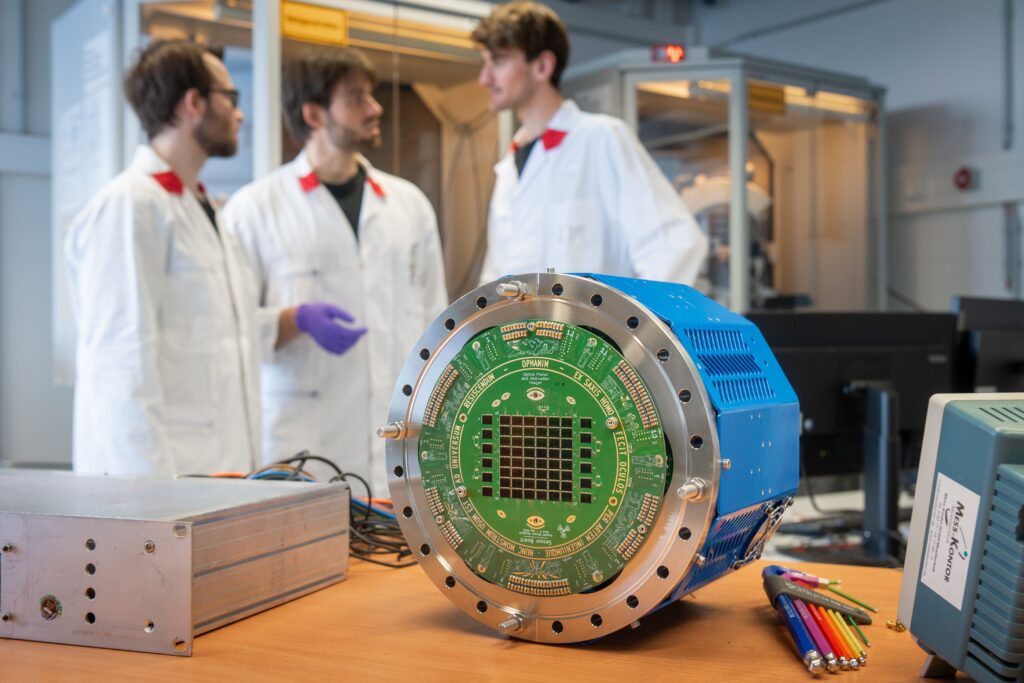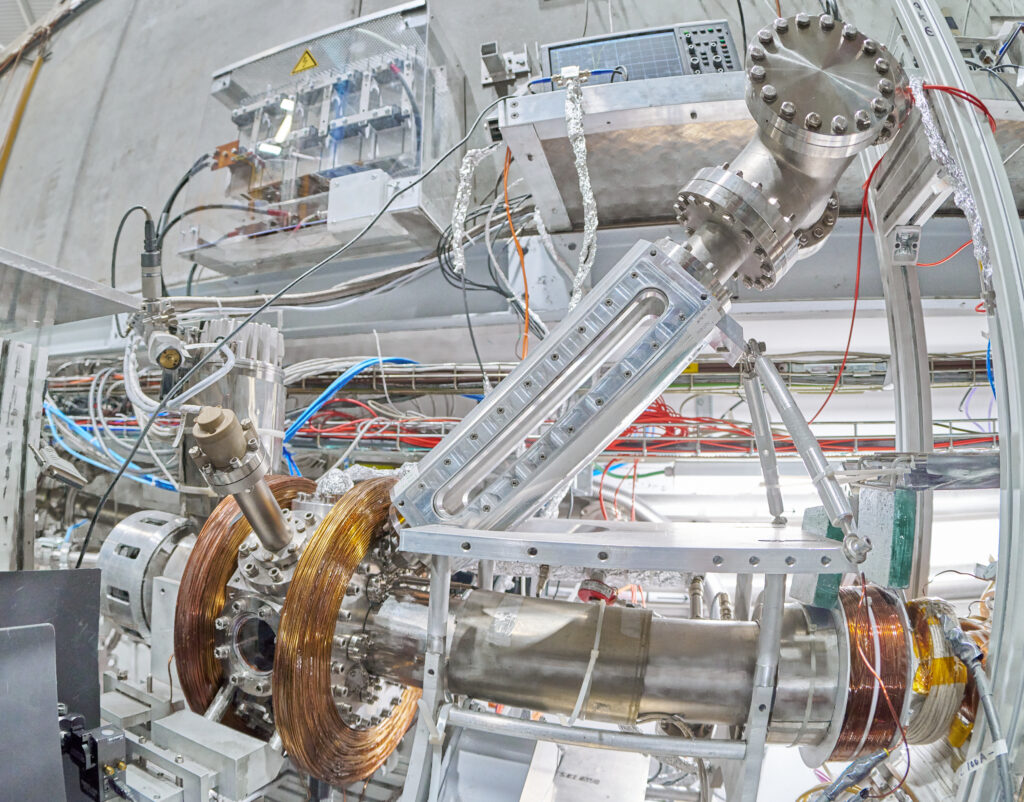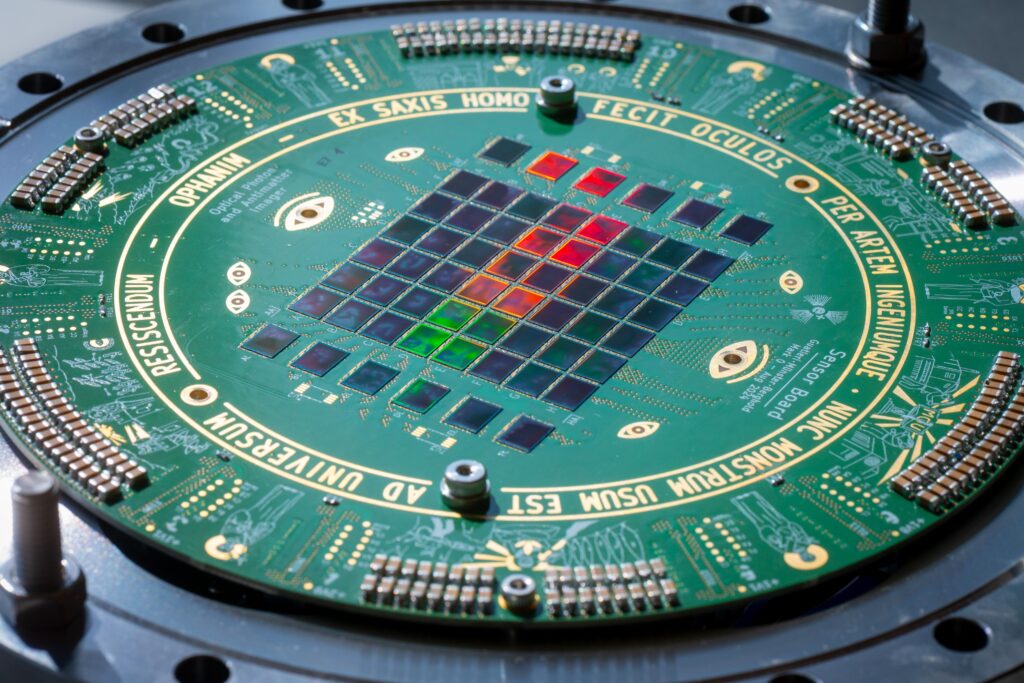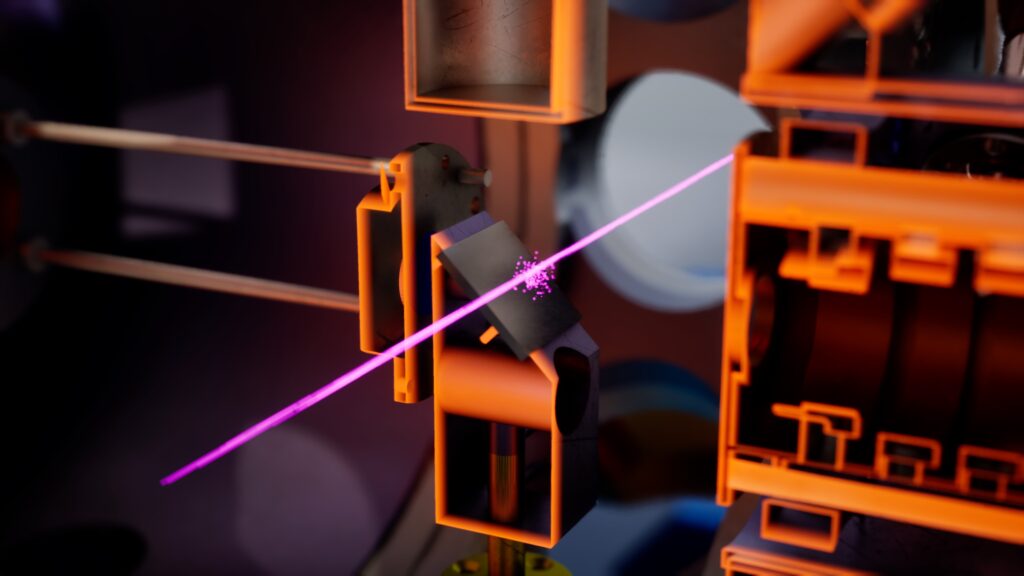Antimatter is one of the most fascinating and mysterious frontiers of contemporary physics. Its discovery has changed how we understand the universe and opened new avenues for exploring fundamental particles. Yet, there are still many unanswered questions about antimatter.
The AEgIS experiment investigates the fundamental properties of antimatter, with a focus on its interaction with gravity. Recently, researchers working on the project managed to take a photo of antimatter using a device with a level of precision never seen before. We spoke with Giovanni Consolati, a professor in the Department of Aerospace Science and Technology, who is involved in the experiment, to gain a deeper understanding of the research’s objectives and its significance to scientists and the broader public.
What follows is a passionate explanation of this remarkable area of study. It touches on the technical difficulties and the potential applications, some of which feel closer to science fiction than everyday reality. Still, the work continues to inspire and raise exciting possibilities for the future.

Giovanni, your career has been closely linked with the study of antimatter. What led you to focus on this field?
I started after graduating in nuclear engineering from Politecnico di Milano. Even at that stage, I had already decided to focus my thesis on physics, and I chose to study positrons. These are particles of antimatter, often referred to as antiparticles, and I found them fascinating. I went on to become a Politecnico researcher. At the same time, I wanted to broaden my education, so I enrolled in a physics degree at the University of Milan and earned a second degree.
This combination of technical and scientific training has proven to be an asset. As an engineer, I understand the practical side of projects, while my physics background helps me engage with more theoretical matters.
As I continued to specialise in the study of positrons, I was invited to join a team forming at CERN to study antihydrogen. That’s an atom made of an antiproton and a positron. I became part of an international research group, which now includes around 50 people.
We launched a highly ambitious project. After more than ten years of work, we are finally beginning to see significant results. The research is highly complex. It is undoubtedly more complicated than the lab-based studies I had been doing before, but it is just as rewarding.

What is antimatter, in simple terms?
If ordinary matter is made of particles such as electrons, protons and neutrons, then antimatter is made of their opposites: positrons, antiprotons and antineutrons. Antiparticles are nearly identical to the particles that make up matter. They have the same mass and physical traits, but their electrical charges are reversed.
What makes antimatter so remarkable is what happens when it comes into contact with matter. The two cancel each other out in a process known as annihilation. Their mass vanishes and is converted into pure energy. This might sound strange, but it is exactly what Einstein’s best-known equation tells us. Energy is equal to mass multiplied by the square of the speed of light. This means that mass can be converted into energy, and energy can be converted back into mass. If electromagnetic radiation has sufficient energy, such as a gamma ray, it can create a particle and its corresponding antiparticle.
Why are scientists so interested in antimatter?
One of the great puzzles in physics is why the universe is made mostly of matter rather than antimatter. The leading theory is that matter and antimatter were created in equal amounts when the universe began. Something must have disturbed that balance, causing antimatter to all but disappear, apart from a few traces. Why antimatter decayed is still a mystery.
We do, however, know how to produce it. How is antimatter made?
At CERN, scientists create antimatter by firing high-energy protons into an iridium target. This generates antiprotons, which are used in various experiments. Still, there is no sign of natural or “primordial” antimatter anywhere in the universe.
What is the AEgIS experiment studying about antimatter?
It is carried out at CERN and involves 16 research institutions from eight countries. Alongside Politecnico di Milano, several Italian organisations take part in the project. These include the National Institute for Nuclear Physics, the University of Brescia, the University of Trento and the University of Milan. AEgIS was created to measure how gravity affects antimatter. This may seem like an obscure goal, but the search for quantum gravity is one of the most significant challenges in contemporary theoretical physics. It would turn the gravitational field into something that fits with quantum mechanics. Gravity is the only fundamental force that remains unexplained by classical theory. One of the central ideas in this area is the principle of weak equivalence. This says that all objects should experience the same acceleration near the Earth’s surface. This principle has been confirmed many times using ordinary matter. So far, we know that there is no such thing as anti-gravity or a force that makes antimatter “rise” instead of fall. However, we still have no direct proof that matter, and antimatter fall with the same acceleration.

What is the biggest challenge in running this experiment?
Antimatter experiments need a neutral system. Charged particles are influenced by electric and magnetic fields, including the Earth’s magnetic field. Gravity, by contrast, is extremely weak.
That is why we work with antihydrogen. It is the antimatter counterpart of hydrogen, and is composed of two antiparticles: an antiproton and a positron. Making antihydrogen is difficult. If the antiparticles touch normal matter, they annihilate instantly.
How is antihydrogen produced in the AEgIS experiment?
There are several ways to create it. We chose a method that looks more complex but offers us some advantages.
At CERN, antiprotons are produced using a high-energy accelerator. These antiprotons are then trapped and cooled using electromagnetic fields. We then bring this cloud of antiprotons into contact with positronium, which is like hydrogen’s little brother. It is a type of short-lived atom composed of an electron and a positron. It is the lightest atom known in nature. Antihydrogen is formed when positronium and antiprotons interact.
This method is more complex than the traditional method of mixing a cloud of positrons and antiprotons. However, it allows us to create a beam of antihydrogen atoms with improved timing and more predictable properties. We do this by exciting the positronium using carefully timed laser beams. This means we know the exact moment when antihydrogen is created.
The antihydrogen beam is then sent through a deflectometer. It is approximately one metre long and tracks its path. Eventually, the antimatter atoms collide with a detector and are annihilated. By measuring the time it takes them to travel and the distance they cover, scientists can trace a parabolic path. This allows them to calculate how gravity affects antimatter.
The experiment has been in development for more than ten years and presents significant technological challenges at nearly every stage. Right now, the team is close to producing a stable beam of antihydrogen. They hope to begin the first direct measurements of how gravity acts on antimatter later this year.
How was it possible to photograph antimatter?
To measure the precise point at which antihydrogen falls, the team, especially the group led by Francesco Guatieri at the Technical University of Munich, devised a clever idea. They used sensors like those found in smartphone cameras to detect particles. These sensors have tiny pixels, smaller than a micron, which allows for extremely high resolution. This level of detail is essential for making accurate measurements. A single sensor is not enough on its own, so they combined 60 of them into an integrated electronic circuit. This created a high-performance detector known as OPHANIM, short for Optical Photon and Antimatter Imager. The system offers a level of resolution similar to that achieved by older nuclear emulsion techniques. The key difference is that results are immediate and do not require painstaking analysis under a microscope.
Crucially, this research is not only a breakthrough in our understanding of antimatter but a significant advancement in the field. It has practical benefits in other areas. The OPHANIM device could be helpful not just in particle physics but in studying electromagnetic radiation. In future, it may lead to significant advances in fields such as biomedical imaging and spectroscopy.

What exactly do the photographs of antimatter show?
Scientists are measuring single events of annihilation, which are detected by specialised instruments called scintillators. For instance, when a positron meets an electron and they annihilate, we do not see the positron’s path directly. Instead, the scintillators detect the gamma rays that are emitted during the event. These rays carry a specific amount of energy. By knowing the average energy released in these reactions, the system can record the time and location of each annihilation at a specific point in the material.
As a result, gamma rays serve as the principal signatures associated with positrons. In the case of antiprotons, things are slightly more complex. Instead of emitting gamma rays, they produce lighter particles known as pions. These, too, are picked up by scintillators. In both cases, the detection is indirect. We do not observe the particle paths directly. What we record are the by-products of their annihilation.
Have there been other significant results from the experiment?
Yes. Last year, we developed a method for laser cooling of positronium. As mentioned earlier, positronium plays a crucial role in producing antihydrogen, along with antiprotons. To improve the accuracy of our measurements, both components must be at a cold temperature. That means they must have low energy. The slower they move, the more precisely we can observe how they fall.
Cooling positronium could lead to ground-breaking developments in the coming years, not in decades. One possible outcome is the creation of Bose-Einstein condensate of positronium. This unusual state of matter was predicted by Einstein in 1924. It occurs when a group of atoms is cooled to temperatures near absolute zero, causing them to exhibit a quantum behaviour on a macroscopic scale. This condensate was proposed by Einstein 100 years ago, in 1924, but it has been possible to create condensates with heavy atoms such as rubidium since 1995.

Making a condensate with positronium would be revolutionary. The biggest difficulty is not achieving ultra-low temperatures. The real challenge is cooling positronium quickly enough, as it is unstable and decays fast. If we succeed, it might be possible to generate pulsed, monochromatic, coherent gamma-ray emissions. These would be like laser beams and could have significant applications in materials science, medical imaging and other advanced technologies.
This type of fundamental research takes time and is often technically challenging. But it has lasting value. Many technological advances have come from trying to solve problems that once seemed purely theoretical or obscure.
Is there a part of your work on antimatter that excites you most?
In recent years, I have been focused on antimatter. However, at the beginning of my career, I primarily worked with positronium. I discovered a vibrant and fascinating field there. In many of my experiments and publications I used positronium as a probe to investigate the properties of materials. Positronium does not form in every material. For example, it cannot be created in metals. However, it does form in amorphous polymers. These are materials composed of large macromolecules that are arranged in a disordered manner.
In these amorphous polymers, there are naturally tiny empty spaces between the molecules. These are known as free volumes. The holes are extremely small, usually just one or a few atoms across. Interestingly, positronium can form inside these spaces.
Studying such small voids is difficult. Currently, there are no standard techniques that enable us to observe free volume directly. Only positronium, used as a probe, can provide this kind of information. The way positronium annihilates reveals the size, shape and distribution of the free volumes. This becomes especially useful when we want to study how a material changes over time or reacts to different temperatures. The data we get from this helps us understand how materials age. It provides insights into structural changes and mechanical properties, such as a material’s resistance to stress.
Thanks to antimatter, and in particular positrons, we can look inside materials in ways that would otherwise not be possible. I have always found this use of antimatter fascinating and devoted much of my professional life to this field.
Antimatter is a popular topic in science fiction. One well-known example is in Star Trek, where antimatter annihilation is used to power the starship Enterprise. But can we use antimatter as a source of energy?
There is a dream of doing just that. The idea is to use the energy released from annihilation to power space rockets. If this became possible, we could, in theory, travel to Mars in an extremely short time. Unfortunately, this kind of application is still far from reality. It belongs more to the Star Trek universe than to current technology. Of course, the future is always open, but for now, we do not anticipate breakthroughs in this area in the coming decades.
There are two main obstacles. The first challenge involves the gamma rays produced during annihilation. Currently, these rays are emitted in random directions. This makes it impossible to focus the energy in a single direction that could be used, for example, to generate propulsion. One idea that might solve this is the creation of a Bose-Einstein condensate. This could potentially enable coherent, pulsed energy emission. However, a Bose-Einstein condensate made from antimatter has not yet been created. So, for now, this remains a theoretical possibility.
The second major obstacle is storing enough antimatter in one place. Right now, scientists can store only a few hundred million antiprotons using electromagnetic traps. To put that in perspective, the largest quantity ever held is around 350 million antiprotons. This is less than one femtogram, or less than 10-¹⁵ grams. It is a frighteningly small amount.
Some estimates suggest that just a few milligrams of antimatter could be enough to power a rocket. But this claim should be taken with caution. To achieve the desired 10-¹⁵ to 10-³ grams, we would need to increase our storage capacity by at least 12 orders of magnitude.
Even if we could produce that much antimatter, we would still need to find a way to store it safely. At present, antiprotons can be kept for only a few minutes or up to an hour. There have been rare cases where a single antiproton was held for a full year. But that was just one particle.
Still, science often progresses in unexpected ways. Technological change does not follow a straight line, and breakthroughs frequently arrive when no one is expecting them. Sometimes a line of research seems to lead nowhere. Then, suddenly an unexpected shortcut appears, opening fresh possibilities. That is the wonder of scientific discovery. You never quite know where the journey will lead.
